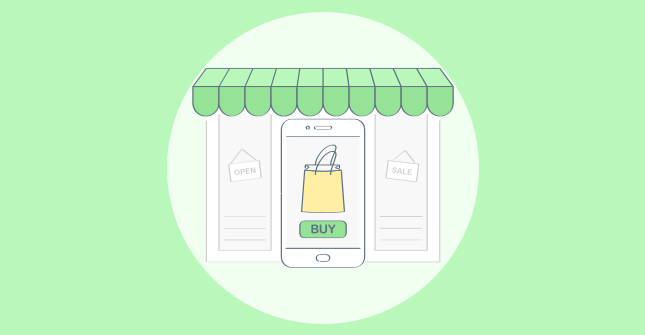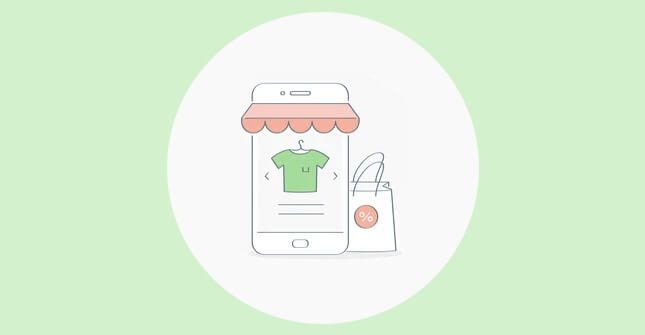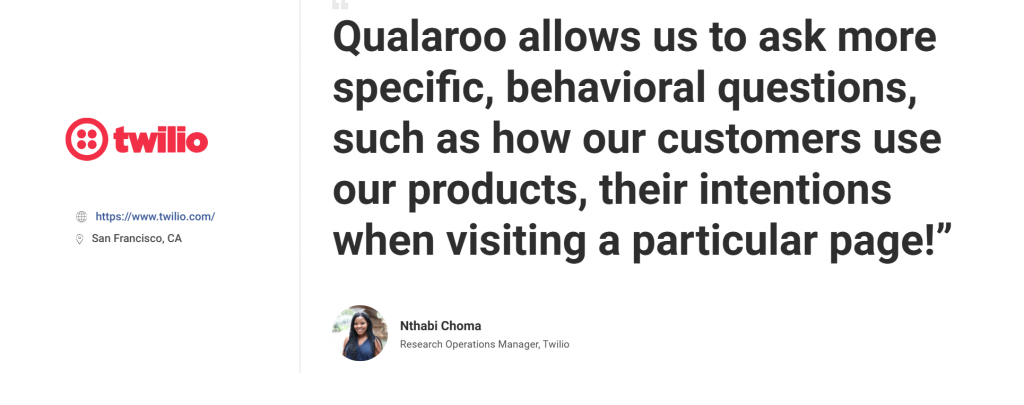Did you know the average website visitor spends less than 15 seconds on a page? With attention spans shrinking, capturing valuable feedback can feel like an uphill battle. Don’t sweat! There’s still a way to go about it—popup surveys.
Popup surveys offer a direct line to your visitors and provide insights into their needs and preferences. But how do you create popups that entice responses instead of clicking the “close” button?
Following a few basic principles, you can create engaging popup surveys that capture attention and valuable insights. I will reveal the secrets to crafting irresistible popup surveys that boost engagement and drive valuable feedback.
Read on to find out.
What is a Popup Survey?
A popup survey (often called an on-site survey, on-page survey, or survey widget) is a type of customer feedback survey that emerges as a popup window on a webpage or within a mobile app. These surveys are designed to capture real-time user feedback and gather valuable insights about their experiences and opinions.
Specific actions or events on a website or app typically trigger these surveys. For instance, they may appear when a user is about to exit a page, has scrolled to a certain point on a page, or has taken a specific action, like purchasing or adding an item to their cart. The timing and placement of popup surveys are crucial to ensure they are not intrusive and do not disrupt the user’s browsing or shopping experience.
Popup surveys often include multiple-choice questions, open-ended questions, and rating scales. Questions may focus on user satisfaction, usability, product quality, customer service, and overall experience. By asking targeted questions, businesses can learn about areas that need improvement and identify opportunities for enhancing customer satisfaction.
5 Benefits of Creating a Popup Survey
Here are some of the benefits you can expect for your business from popup surveys.
Get Your Hands on Reliable Data
Data is endless. So much so that you can even buy it (Crazy, right?)
But not everything is what you call reliable or even suitable.
Your business is unique. The insights you need to make your business the best of its version should also be unique, i.e., they should come from your customers.
Pop-up surveys get you responses from your customers and prospects based on their experiences with your products and services, preferences, and opinions. This feedback data is highly reliable, so you can do right by your business and customers by acting on it.
For example, say you need to improve your conversion rate but have no idea how.
Instead of relying on what you find on Google, find solutions within your business. By that, we mean analyzing your strengths and weaknesses and figuring out who can better tell you about those besides your customers.
Capture Feedback in Real-Time
Popups appear in front of customers when they are on your website or mobile app.
So, if you want to instantly get a hold of your customer’s attention and collect quick feedback, don’t hesitate to shoot surveys using popups.
For example, if you use an email or SMS survey, one of the two scenarios may happen:
Scenario A: Customers will not respond as they might forget to answer or simply ignore your survey.
Scenario B: If they answer, they’ll respond as per their accord.
And that’s why popup surveys are the most effective in getting real-time feedback.
Unclutter Your Website/Mobile App
Ask yourself, which do you enjoy more? – A website with so many elements thrown together you don’t know where to look, or the one with a pleasing and simple UI?
*Secret hint – We’re looking for an answer along the lines of the latter.
Adding too many elements to your website or mobile app can render the user interface unattractive and cluttered. Since popup surveys are not a permanent part of UI, they don’t take up space, leaving room to add other useful elements like CTAs, inline tips, etc.
Instead of a static survey module, popup surveys are better at grabbing your customers’ attention while ensuring your website is functional and aesthetically pleasing.
Doesn’t Redirect Your Traffic
Unlike old-school surveys, which require you to leave the current page and go to a whole new survey page, popup surveys are like little windows that pop up right on the current page.
That means people can give your feedback without leaving the page, which is cool because it makes it less likely for people to close the tab and leave your website altogether.
The best part is that these popup surveys don’t mess with your browsing experience. They just sit quietly, waiting for you to give your feedback. This way, popup surveys do not increase page bounce rates while collecting customer feedback data.
And since people can give their input right away, companies can get valuable insights while the experience is still fresh in their minds. This means businesses can make quick changes and improvements to their website or product based on the feedback they receive.
Easy to Gather Contextual Data
Unlike email surveys, you can place popup surveys anywhere on any website page and whenever you prefer. It helps businesses like you collect in-context customer feedback.
For example, you can set trigger events for pop-up surveys to make them appear at a specific time or after a particular action is performed.
Online pop up survey tools like Qualaroo offer advanced targeting where you can also target visitors based on their browsing history, browser, device, and geographic location to collect contextual feedback.
CASE STUDY: KingsPoint
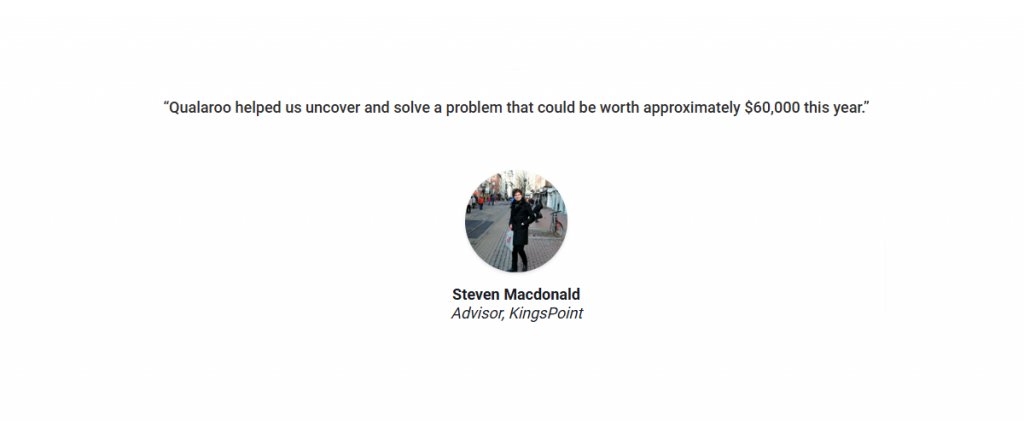
KingsPoint assists companies in improving their website conversions with bespoke conversion solutions. The clients have unique problems that KingPoint analyzes and resolves.
So, to analyze their customers’ problems, Kingspoint used Qualaroo’s NudgesTM on website pages such as checkout, products, resources, etc., to gauge visitors’ feedback.
They asked questions like:
- What stopped you from purchasing today?
- What can we do to improve our website?
- What information is missing from this page/website?
Through questions like this, the Kingspoint team found the issues in their clients’ websites and were able to improve the conversions.
6 Tactical Ways Companies Use Popup Surveys
Popup surveys are versatile. You can use them throughout the customer journey at different touchpoints. Here are a few examples of popup use cases:
Identifying Profitable Marketing Channels

Prospects land on your website from different sources. Of course, you can identify which browser or device they came from, but it’s challenging to find the marketing channels doing the magic for you.
So, what to do?
Easy – Ask the customers.
Here’s a great example of how an industry leader in the online education space redesigned its marketing strategy based on feedback from pop-up surveys.
CASE STUDY: Udemy
Udemy is blessed with high website traffic from different marketing channels, so the team wanted clear insights into which channels are bringing the most traffic.
They turned to the feedback software Qualaroo’s popup surveys to ask the new users on the website how they found out about the learning platform.
The insights helped them reallocate their advertisement resources to marketing channels that worked for them.
Turning Visitors Into Quality Leads
You need to master your timing, whether cooking a delectable pizza in the oven or showing your popup surveys to visitors.
Both will get ruined if you miss the right time window.
Not sure about the pizza, but you can shoot a pop up survey online 10-15 seconds after the visitors arrive on your website or when they are about to leave the page.
You can ask them how they found out about your business or if there is something specific they are looking for. In doing so, you can effortlessly collect contact information and generate new leads.
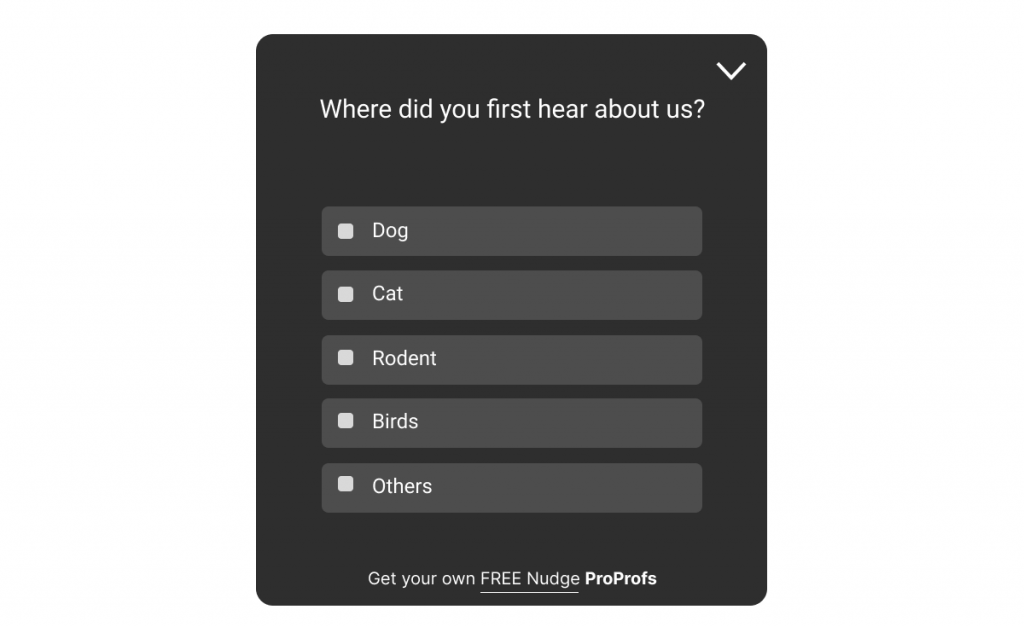
Gauging Onboarding Experience
You can add pop-up surveys at the post-onboarding stage. These can help you understand how helpful your onboarding process was and what else you can do to help new customers navigate your product.
Simple questions such as “Was the onboarding process helpful?” and “How easy was it for you to use the tool the first time?” go a long way in getting the insights you need.
Tracking Customer Satisfaction Metrics

Customer satisfaction metrics are user experience markers that businesses use to track their performance on various fronts. For example:
- Net Promoter Score helps you identify your loyal customers and detractors. You can deploy popup NPS surveys in your product or website and ask people this simple question:
- Customer Satisfaction Popup Surveys gauge the overall satisfaction level of your customers with your services/company/products.
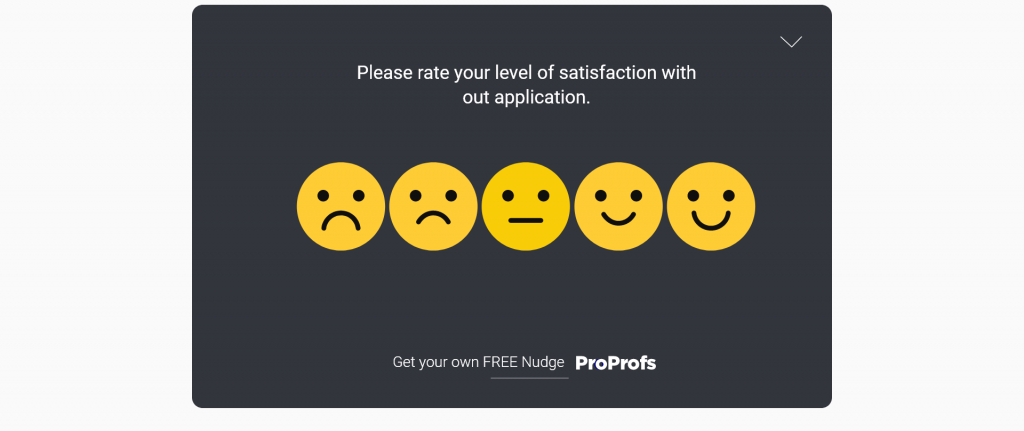
- Customer Effort Score is a metric that explores how easy it is for customers to get their queries resolved. You can deploy these popup surveys in your product or prototype.

- System Usability Score gauges the experience of a software product, i.e., how it performs for users. You can conduct this survey on your software product or its prototype to validate it.
Identifying Upsell Opportunities
Online upselling is the equivalent of a salesperson in a store saying, “Wow! That tux really suits you. Why don’t you pair it with our new premium tie launch?”
But online, you can be more creative and dig deep into customers to recommend things they can’t resist. Pop-up surveys can help you map customers’ behavioral and psychographic data to upsell your products.
A widespread practice in businesses is to use popup surveys to collect customer feedback and combine it with data like purchases and browsing history to recommend products at checkout.
CASE STUDY: AWA Digital
Avis, a leading car rental company, wanted to promote its other add-on services, such as navigation systems, child-protected seats, and additional insurance, in addition to renting cars.
They approached AWA Digital, a company that helps its customers improve online sales, to increase the number of units per purchase and the overall revenue.
AWA Digital used Qualaroo’s popup surveys to directly ask the customers which items are more valuable and popular among them.
“Qualaroo enabled us to get customer insights that we couldn’t get elsewhere,” said Jonny Green, Conversion Optimizer.
AWA Digital then promoted the popular add-ons using pop-ups before the booking stage, which increased revenue.
Exit-Intent Surveys to Retain Customers
In brief, exit-intent surveys are popup surveys set to appear as website visitors are about to leave a website. ECommerce websites use them as an effective conversion rate optimization strategy to reduce cart abandonment rates.

You can place an exit-intent pop-up on the website or specific landing pages with a high bounce rate to understand what is missing on the page that customers are looking for. This way, you can optimize your relevant landing page for your target audience.
CASE STUDY: Belron
Belron offers a straightforward yet crucial service – windshield repair. Even though the target audience for this company is the people who want to replace their broken windshield with a new one, their website had a high bounce rate.
Baffled, the team decided to ask the leaving customers themselves since they were the only ones with the correct answers. They deployed exit-intent surveys on their landing page to ask customers what information they sought on the site.
From their responses, the company found an entirely new buyer persona the team didn’t even know existed until that point. It helped them create strategies around the newfound persona and convert them into customers.
10 Popup Survey Best Practices
At the risk of repeating myself, adding web popup surveys will only work if you do it right. With these popup survey best practices, you can design delightful popup surveys that bring a high response rate and valuable insights.
Set a Clear Goal for Popups
Like anything else, you first identify your objective and set a goal in mind.
So, before designing popup surveys, analyze your customer journey, gaps, challenges, and business processes to identify where you can leverage these surveys.
Suppose you found that certain website pages are not performing as they used to during your analysis.
In that case, you can deploy popup surveys on those pages and ask customers what they couldn’t find, what they would like to see on the page, and their overall experience.
Similarly, if you face cart abandonment on your website, you can employ exit-intent surveys to understand why they didn’t purchase, explore customer experience, and how you can improve it.
Deploy on the Right Pages
Popup surveys can give excellent results if deployed in the right place. Based on the purpose and type of popup survey, it’s easy to decide where to deploy them.
For example, to gauge your users’ loyalty toward your product and brand, you must deploy an NPS popup survey while your customers use your product.
Here’s an in-house example:
Qualaroo conducts in-product NPS surveys as users are using the product. This ensures a high response rate and customer engagement.
And no, you won’t be hampering the customer experience since these popup surveys appear on the corner of the screen and don’t take up an overwhelming amount of space that may seem intrusive.
Target Specific Customer Segments
You need to consider ‘Who you are going to ask.’ Each popup survey type aims to gauge specific information from a target customer segment.
Suppose you want to identify new feature opportunities for your product. In that case, showing your survey to new prospects who have just signed up or are on a free trial is not wise since they haven’t used your product enough to give you reliable feature suggestions.
The ideal segment will be customers using your product for a while who can speak from their experience.
The best way to segment prospects or new customers from your paying customers is through screening questions, popularly known as screeners.
With screening questions, you can leverage branching and skip logic to eliminate unsuitable respondents and zero in on your target audience.
Choose the Right Answer Options for Question Types
You can kiss accurate and valuable customer insights goodbye if you don’t design a survey with the right questions and answer types.
It is one of the typical survey mistakes people make while designing surveys. For example, you may confuse a single-choice answer option with a multiple-choice one for a question that requires a multiple-choice answer.
For Example:
“What type of pets do you have?”
In this scenario, respondents can have more than one pet. If you place a single-choice answer type, they will be forced to choose only one option, and you won’t get accurate data.
You might not be a professional in making surveys and be prone to making mistakes, and understandably so.
For this, you can either refer to a rich question library with hundreds of questions and answers to choose from or keep reading, as we will discuss in the next section.
Consider Timing and Placement
We can’t stress the perfect timing enough.
If you show the popup too early, customers will not engage with it or share random feedback, and if you show it too late, they might ignore it.
The timing you choose also depends on the survey type. For example, if you are conducting an exit-intent survey, you must time it when customers are about to leave the website.
Similarly, if you are conducting an NPS survey, show the popup after the customers spend X amount of time on the website to keep them engaged.
As for the placement, you need to explore the right place for your popup on the screen besides selecting the right landing pages.
Tools such as heatmaps and session recorders allow you to identify the most interacted places on your site, i.e., places customers are most attracted to and click on the most.
These tools will help you understand customers’ behavior on your website to plan your popup surveys accordingly.
Note*
If you are looking for an online feedback tool to help you track customer behavior on-site, look no further. Qualaroo integration with SessionCam offers all this and more.
Avoid Question Overload in Popups
Popup surveys are a means of collecting quick customer feedback. However, adding too many questions in the attempt to collect leads or data will defeat the whole purpose.
Imagine yourself as a respondent; if you had to answer a survey with endless questions, you would become frustrated, right?
Here’s an example.
Say you create a popup survey to identify which marketing channels bring you the most leads and traffic.
Now, you shouldn’t go overboard and ask questions like:
- How did you find out about our company?
- Out of these, how many marketing channels did you see our company on?
- Did you come across any ads about our product on the XYZ platform?
Instead of asking these three questions, a simple question like “Where did you first hear about us?” would provide all the valuable data you need.

Balance the Open-Ended and Closed-Ended Questions
Open-ended questions are very effective in getting you in-context feedback. But if you think from the respondents’ point of view, too many open-ended questions would look too greedy.
Getting respondents to take the survey is challenging enough, and if you keep asking for feedback via open-ended questions, they might feel overwhelmed and abandon the survey altogether.
Why?
Open-ended questions require respondents to express their views in detail, which is time-consuming.
So when it’s qualitative research vs. quantitative research and which question type to use, remember this:
Open-ended questions help you get qualitative insights, whereas closed-ended questions are great for collecting quantitative data.
If you think a closed-ended question can provide the desired feedback better than an open-ended question, go with that.
Avoid Asking Leading Questions
Leading questions carry the researcher’s biases towards a particular answer choice. If you frame a leading question for your survey, respondents may answer what they think you will favor more to impress you, skewing your feedback data.
Instead of discussing what TO do, let’s see what NOT TO do.
For starters, avoid adding words like “right” to your questions. Such words validate what you are asking in the question, and respondents may answer “Yes” to be agreeable.
Additionally, try not to use words that directly refer to a sentiment.
For example, instead of writing — “On a scale of 1-10, how much will you rate your hate for Pineapple Pizza?” — it’s better to write something like “On a scale of 1-10 (1 being terrible and 10 being incredibly delicious), what do you think of Pineapple pizza?”
Here, the word “hate” implies that you, as a researcher, share this emotion towards Pineapple Pizza, making respondents biased to rate a low score.
Employ Strong CTAs and Visuals
Although popup surveys are supposed to be quick, that doesn’t mean they have to be boring without great visuals or CTAs.
People often focus so much on asking the right questions that they forget to make their popups appealing using visuals. It would help if you tried using visuals with two-step popup surveys, as shown in the image below.

With visuals, you can also add important CTAs to capture quality leads while collecting customer feedback. Make sure to highlight your CTA so that customers can quickly identify it.
Pro Tip:
Besides all the best practices for popup surveys you just read, you should give A/B testing your surveys a go. This way, you’ll be able to test your surveys and choose the one that gets you the most relevant data with a high response rate.
Encourage People With Incentives
Nothing comes free, especially not your visitors’ time and efforts. So, if you want people to take your survey, you have to give them a reason.
You can offer discounts, deals, gift vouchers, and other monetary incentives to motivate people to engage.
One of the effective ways to do so is to use popup tools like Picreel that help create interactive and attractive popups. These pop ups make your visitors aware of your incentives and loyalty program.
FREE. All Features. FOREVER!
Try our Forever FREE account with all premium features!
30+ Popup Survey Examples
In this section, you’ll get to know the right popup survey questions to ask your customers. We have segregated these survey questions based on customer journey stages and where you can use them.
So, consider asking these questions if you look forward to launching popup surveys on websites.
Questions for Market Research:
- How much would you expect to pay for the Product/Service?
- Is our brand’s purpose evident to you?
- Why do you prefer to buy from us?
- Which brand of [product/service] do you prefer?
- Have you heard of our products/services before? If so, how did you come across our brand?
Here’s an example from TFS Loans:

- When you think of [product name], which brand comes to mind?
- What have you heard (positive and negative) about our company/products?
Questions to Ask Your Prospects:
- Is there anything on this website that doesn’t work how you expected it to?
- What problems/pain points are you trying to solve?
- What are your biggest challenges with the current market offerings?
- Please explain your first impression upon interacting with our company for the first time.
Questions to Ask Pre-Purchase:
Here’s how Flip.hu collects feedback via exit-intent popup surveys from their website visitors for not purchasing:

Other exit-intent questions:
- Is our pricing clear?
- Please tell us how we can improve our checkout process.
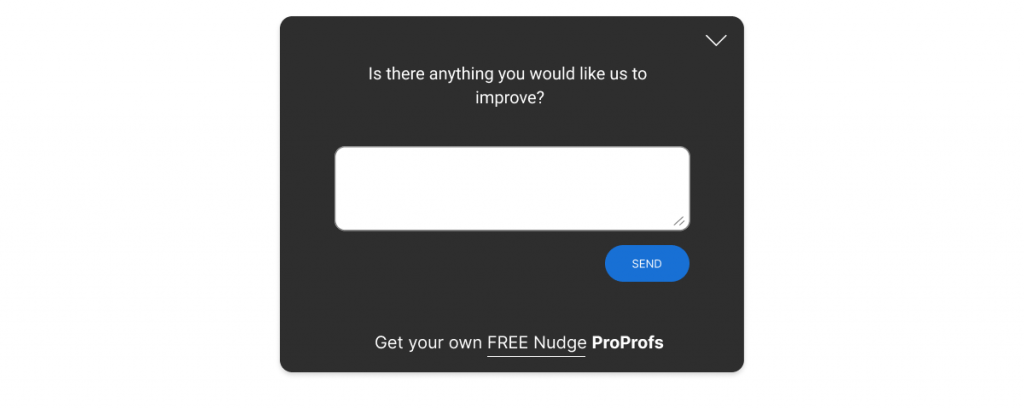
- What stopped you from making a purchase today?
- Is there anything we can do to help you complete the purchase process?
- Do you feel our prices are competitive?
- Were you looking for a discount or promotion?
- Did you find our shipping costs reasonable?

Questions to Ask Post-Purchase:
- Was there anything about this checkout process that we should improve?
- Can you please explain your purchasing experience with us?
- How likely are you to purchase from us again?
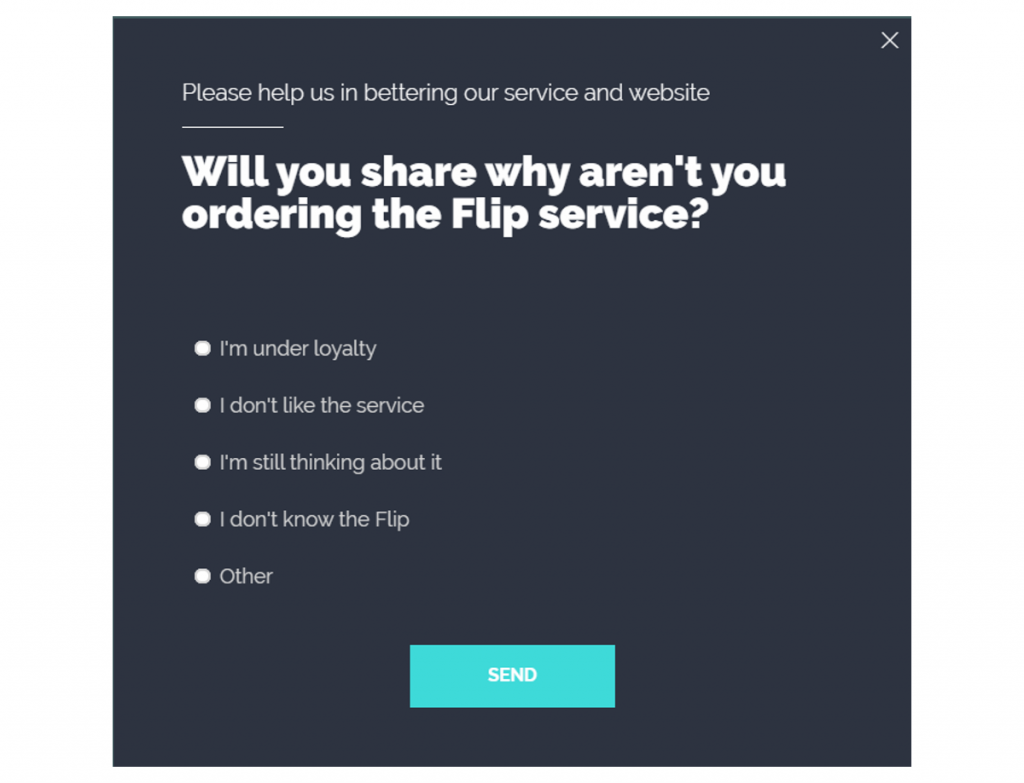
- How would you describe your last experience with us?
- What’s the one thing that nearly stopped you from buying from us?

- Did you interact with our customer service team during your purchase?
- If so, how would you rate the quality of service you received?
Questions to Ask During/After the Onboarding Stage:
- Did you find the onboarding process helpful?
- Is there anything critical to your success that wasn’t covered during our onboarding process?
- How easy was it for you to use the tool the first time?
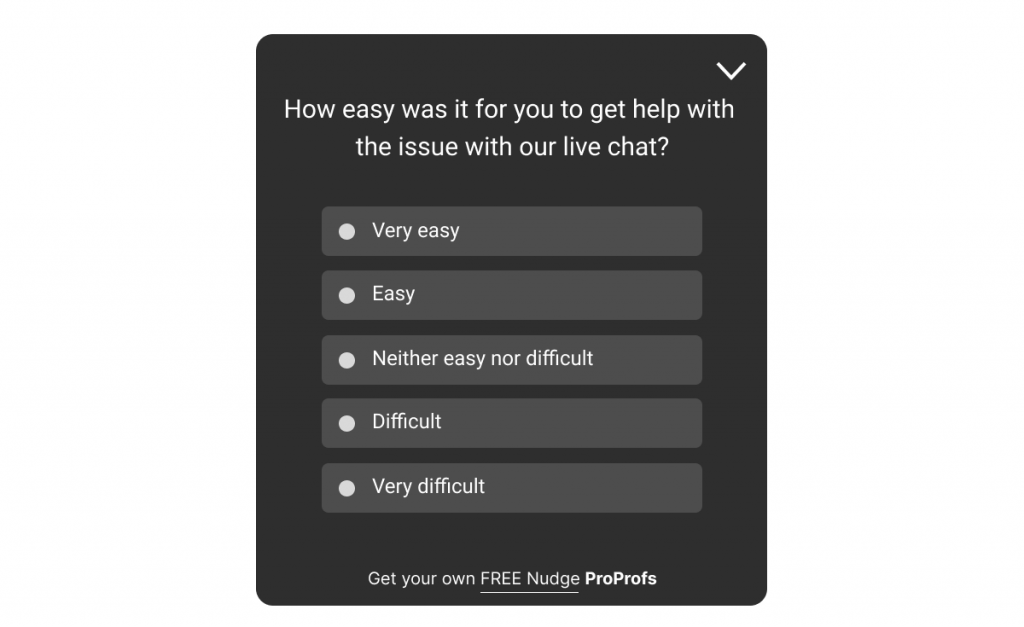
- Do you feel our product is going to help you achieve the goals that you want to achieve?
Questions to Ask for Product Experience:
- If you could change one thing about [product/service], what would it be?
- How can we make [product/service] easier to use?
Questions to Gauge Customer Satisfaction (CSAT) & Loyalty (NPS):
- How would you feel if you could no longer use our product/service?
- Are you satisfied with the quality of our products?
- How was your overall experience shopping with us?
- On a scale of 0-10, how likely are you to recommend our brand to your friends and family?
5 Best Tools to Create a Popup Survey
You can choose from various tools to create website survey pop-ups. But with a hundred choices also comes confusion. Don’t worry; you won’t be leaving without a solution.
Here are our top recommendations for tools to create flawless popup surveys.
1. Qualaroo
Qualaroo customer experience management software offers various popup surveys, such as NPS, CSAT, CES, SUS, exit Intent, marketing, and many more. As a business, you can use these surveys at various touch points in your customer journey and track crucial metrics.
You should pick Qualaroo because it:
- Has branching and skip logic to add an extra layer to your surveys and collect in-context feedback.
- Offers multiple question types, such as rating scale, Likert scale, MCQ, and more, so you can ask questions however you want and get precise feedback.
- Comes with numerous pre-designed templates.
- Supports advanced targeting to help you ask the right questions at the right time to the right people.
- Has a vast question library to pick questions.
- Integrates with many tools such as Zapier, Salesforce, and MailChimp, to name a few.
2. Survicate
Survicate is another excellent option to deploy website survey pop ups, capture new leads, perform market research, collect user feedback, and more. It offers features such as:
- Manage feedback from multiple sources.
- Create surveys like NPS, CSAT, CES, Exit-intent, and more.
- Integrate with tools like HubSpot, Google Analytics, etc.
- Offers 125+ survey templates.
- Allows you to add popup surveys on your website and mobile app.
- Monitor and manage feedback using its Feedback Hub.
3. ProProfs Survey Maker
ProProfs Survey Maker tool lets you create forms, surveys, polls, and more. It is a straightforward tool to use with a low learning curve. Some of its helpful features are:
- Has 1,000,000+ goal-oriented questions for you to use in surveys.
- Has a drag-and-drop editor to create surveys.
- Lets you customize and personalize your surveys.
- Offers seamless integration with MailChimp, and Zendesk, among other tools.
4. Picreel
Picreel is a reliable website survey popup tool that lets you create attractive popups and collect precise customer feedback. It helps you convert website visitors by asking them about their experiences.
It saves all the data in the cloud and offers you different pop-up templates to choose from. Some of its features are:
- Helps you create two-step popups.
- Integrates with numerous platforms and tools like Zapier and One-click.
- Enables you to add interactive CTAs.
- Offers redirect link overlays, lead form overlays, deals, and offer overlays.
5. SurveyMonkey
SurveyMonkey is yet another great tool to create your popup surveys. You can create pop-up surveys like NPS and CSAT to collect quick customer feedback. It comes with features like:
- Integrates with HubSpot, Automate.io, and more.
- Supports question randomization, offers a progress bar, a scoring mechanism, etc.
- Comes with pre-designed survey templates to save you time.
- Translates surveys to help you reach more audiences.
How to Create a Popup Survey in 10 Minutes
Now that you know the top tips for creating and launching engaging popup surveys on a website, it’s time to talk business—how to create popup surveys in simple steps.
Here’s our detailed video on designing effective popup surveys. You can also check out the following steps that showcase how to create survey intercepts called Nudges™ using Qualaroo.
Step 1: Click the “Create New” button on your dashboard interface.

Step 2: Choose a Nudge type based on where you want to place it – desktop, mobile web, for a prototype, iOS, and Android apps. You can also share it as a link.
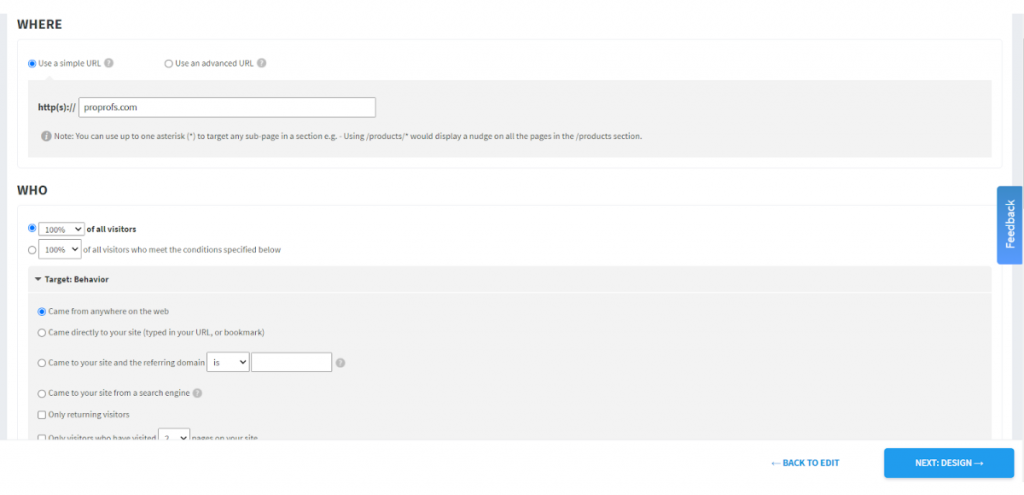
Step 3: Click on the “Choose Template.”
Select one survey template from NPS, a five-second test, buyer persona templates, and more. You can also create one from scratch by choosing the “New from scratch” option.
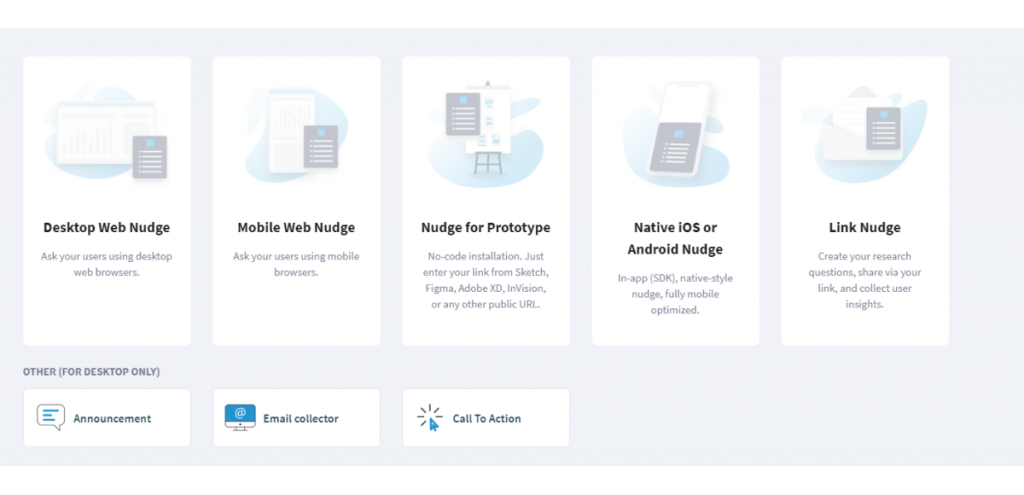
Step 4: Click “Next” and enter the URL of the website and pages on which you want to add the survey.

Step 5: Click “Create” to add or edit questions.
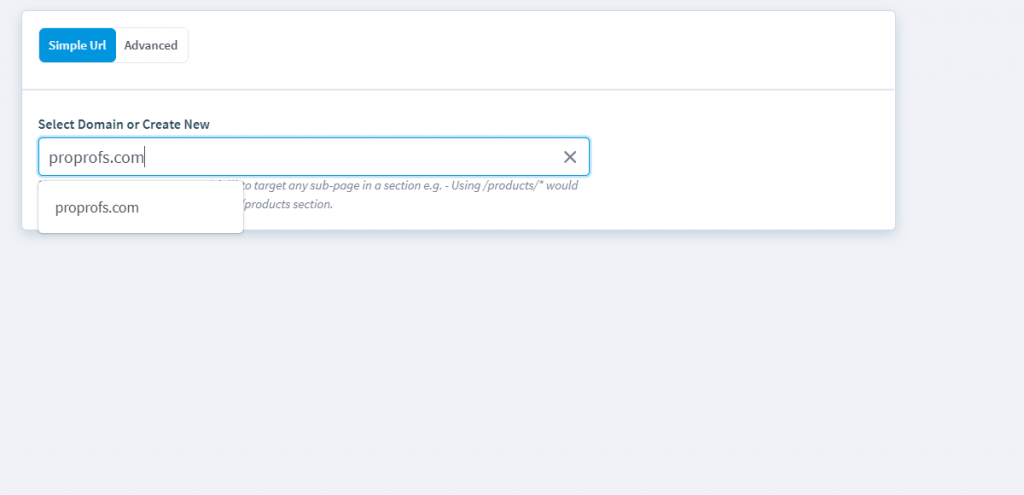
Step 6: Customize, add questions and choose your answer type like radio button, multiple-choice, Likert Scale, etc. You can leverage branching logic to add follow-up questions and get deeper insights from the respondents.

Step 7: Select the “Targeting” option.

Use advanced targeting to reach the right audience for your survey and get accurate and meaningful feedback.
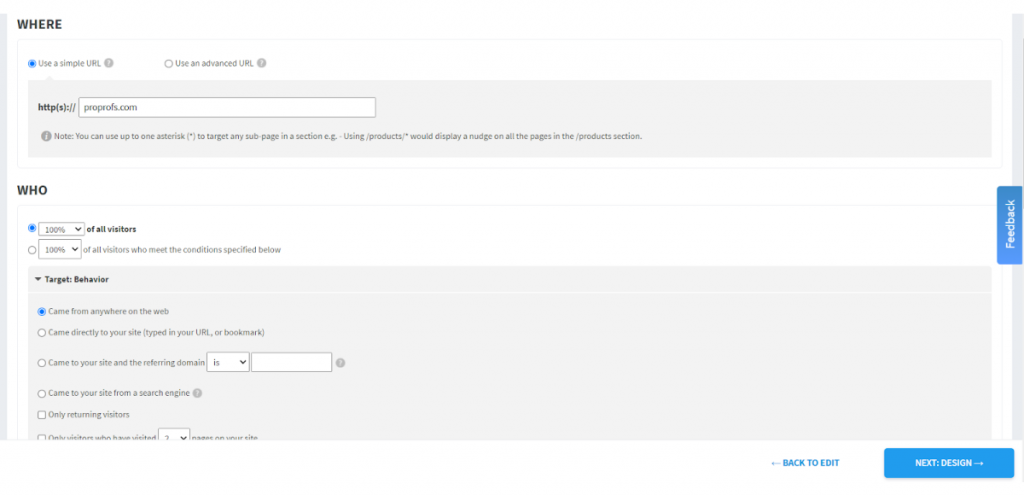
Step 8: Now click ‘Design.’ From here, you can personalize the pop-up survey to suit your branding by changing its color, font, and more.

Don’t forget to ‘Save’ it once you’re done, and make sure to preview your pop-up survey and activate it when you are ready to shoot it.
Creating a popup survey is not the end of the journey. Once the survey pulls visitors’ responses, you should analyze the data to make sense of the feedback.
The great thing is that Qualaroo offers an analytics dashboard for Sentiment Analysis. This technology scans all the responses and tells you the emotions displayed in them.
So, if you want to know how your customers feel (literally) about your brand/product/service or what’s trending among them, leverage this feature and analyze the vocabulary representing the emotions through word clouds.
It’s way easier than crunching massive data with numbers and free-range responses!
Use Popup Surveys to Capture Quick, Reliable Feedback
We’ve explored the ins and outs of popup surveys, from understanding their unique advantages to knowing when they shine compared to other feedback methods. Remember, the key to creating irresistible popups lies in being respectful, concise, and relevant.
Following our tips, you can transform those potentially annoying interruptions into valuable opportunities to connect with your audience and gather those golden nuggets of insight.
So, what are you waiting for? Start crafting those engaging popup surveys today and unlock the power of user feedback! With a little creativity and the right tools like Qualaroo, you’ll be well on your way to creating a user experience that truly rocks.
 Tips
Tips
We’d love to hear your tips & suggestions on this article!
FREE. All Features. FOREVER!
Try our Forever FREE account with all premium features!

 We'd love your feedback!
We'd love your feedback! Thanks for your feedback!
Thanks for your feedback!

